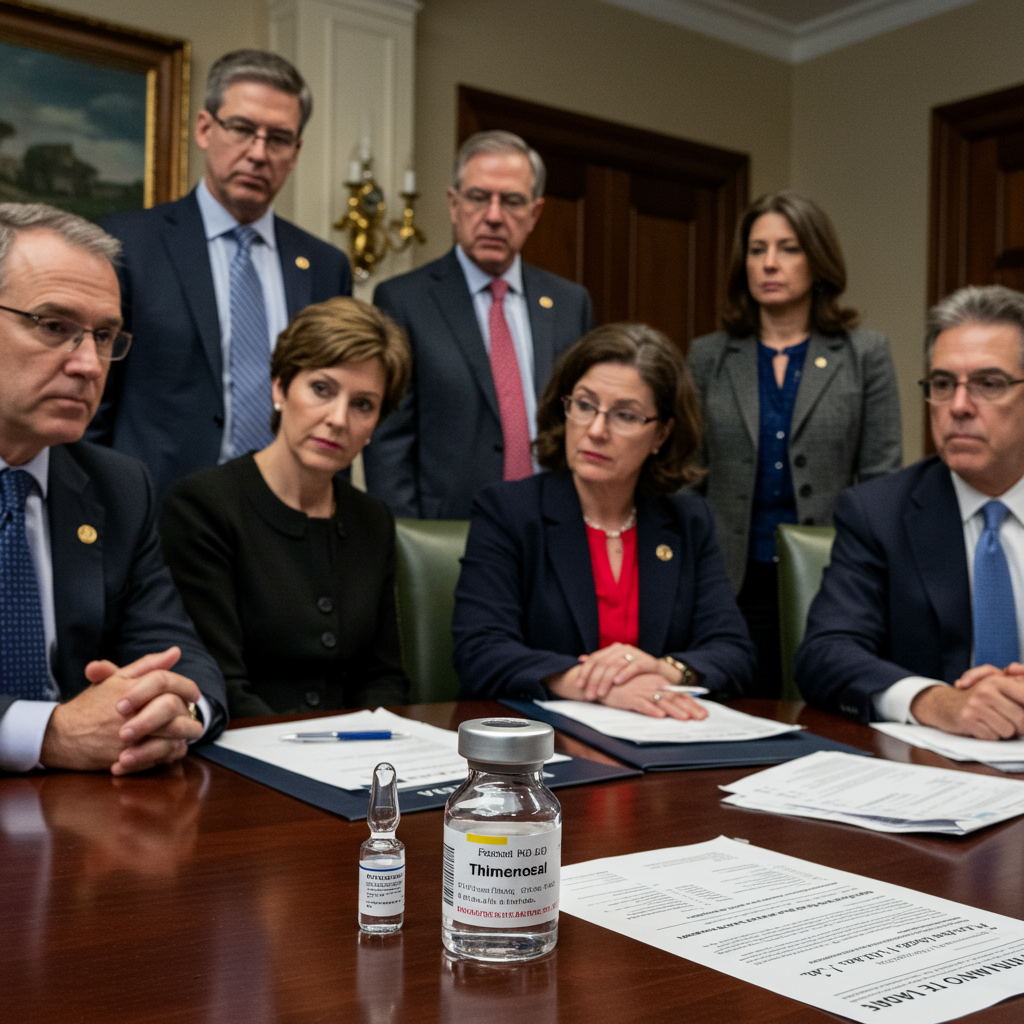A vaccine ingredient known as thimerosal is once again in the spotlight, following a controversial recommendation by federal health advisors. This preservative, containing a form of mercury, has been used in certain vaccines for decades but has faced persistent, though widely disproven, safety concerns. Recent actions by a newly appointed advisory committee are prompting a closer look at what thimerosal is, its history, its safety record, and its minimal presence in today’s flu shots.
In a move that surprised many public health experts, the Centers for Disease Control and Prevention’s (CDC) Advisory Committee on Immunization Practices (ACIP) recently voted to recommend using only thimerosal-free single-dose flu vaccinations for all age groups. This decision comes shortly after Health Secretary Robert F. Kennedy Jr. replaced the committee’s previous members. While the vast majority of flu shots administered in the United States are already thimerosal-free, the focus on this ingredient by the new ACIP raises questions about the process and priorities shaping vaccine policy.
What Exactly is Thimerosal and Why Was It Used?
Thimerosal is a chemical compound that contains ethylmercury, a form of mercury bonded to ethyl alcohol. It was first introduced in the 1930s and quickly became a common preservative in multi-dose vials of vaccines and other medications.
Its primary function in vaccines is to prevent the growth of potentially harmful bacteria and fungi. When a healthcare professional draws a dose from a multi-dose vial, they puncture the rubber stopper with a needle. Each puncture presents a small risk of introducing microbes into the vial. Thimerosal acts as a safeguard, inhibiting contamination that could otherwise render the remaining doses unsafe or ineffective.
Multi-dose vials offer practical advantages, especially in certain settings. They are often cheaper to produce and purchase than individual pre-filled syringes. They also take up less storage space in refrigerators, which can be a significant factor for clinics and public health programs that order large quantities of vaccine doses before flu season begins.
Addressing Mercury Concerns: Ethylmercury vs. Methylmercury
Any discussion of thimerosal inevitably involves its mercury content. Mercury is a heavy metal that can be toxic in certain forms and amounts. However, not all forms of mercury are the same, and understanding the distinction is crucial for evaluating thimerosal’s safety.
The mercury in thimerosal is ethylmercury. This is different from methylmercury, the form found in some types of fish, which can accumulate in the body and lead to health problems. The body processes and eliminates ethylmercury much more quickly and efficiently than methylmercury, primarily through the kidneys. This difference in how the body handles the two compounds gives them distinct risk profiles. Regulatory bodies and experts, including the Food and Drug Administration (FDA), have long stated that the trace amounts of ethylmercury in vaccines are not harmful.
The Phasing Out of Thimerosal: A Precautionary Step
Concerns about mercury led the U.S. government to evaluate its presence in childhood vaccines in the late 1990s, prompted by the 1997 FDA Modernization Act. Although studies at the time found no evidence that the low doses of ethylmercury in vaccines caused harm, public health officials and vaccine manufacturers agreed to reduce or eliminate thimerosal from childhood vaccines as a purely precautionary measure.
By 2001, thimerosal was removed from nearly all routinely recommended vaccines for children age six and younger in the United States. This action was taken out of an abundance of caution, aimed at reducing overall infant exposure to mercury from all sources, even though the specific form of mercury in thimerosal was not linked to health issues at vaccine dose levels. Vaccines like MMR (measles, mumps, rubella), varicella (chickenpox), and polio vaccines never contained thimerosal in the first place.
Debunking the Discredited Link to Autism
Perhaps the most persistent controversy surrounding thimerosal is the claim that it causes autism. This concern gained traction following a now-infamous 1998 study published in The Lancet by Andrew Wakefield, which suggested a link between the MMR vaccine and autism. It’s important to note that this study focused on the MMR vaccine, which does not contain thimerosal.
Wakefield’s study was later found to be based on falsified data, he lost his medical license, and the article was fully retracted by The Lancet, with a prominent medical journal calling it an “elaborate fraud.” Despite this, the false link between vaccines and autism persisted and expanded to include thimerosal.
Numerous subsequent studies and reports from leading scientific and medical organizations worldwide have repeatedly and conclusively shown there is no association between thimerosal in vaccines and autism or other neurodevelopmental disorders. Reports by the National Academies of Sciences, Engineering, and Medicine, and studies published by the CDC in 2004, 2006, 2007, 2009, and 2010, among many others, have all reached the same conclusion: thimerosal does not cause autism. Adding further counter-evidence, experts point out that rates of autism have continued to rise over the past two decades, even after thimerosal was removed from most childhood vaccines. This pattern is inconsistent with thimerosal being a causal factor.
Thimerosal in Today’s Flu Shots: A Minimal Presence
For most people in the United States today, thimerosal is simply not an ingredient in their routine vaccinations. Its remaining use is primarily confined to a small proportion of multi-dose vials of flu vaccine.
According to CDC data, in the 2024-25 flu season, approximately 94% of flu shots administered were thimerosal-free or contained only trace amounts. This means that the vast majority of flu vaccines are already supplied in single-dose, pre-filled syringes that do not require a preservative like thimerosal because they are used only once.
While multi-dose vials containing thimerosal represent a small fraction of the total supply, they remain important for some clinics and health centers due to their lower cost and storage efficiency. Manufacturers like Sanofi and Seqirus, who produce these vials, state that thimerosal-containing doses make up a very small part of their overall flu vaccine production.
The Recent Recommendation and Expert Concerns
The recent ACIP recommendation against using thimerosal in single-dose flu shots is seen by many experts as addressing a problem that largely “doesn’t really exist anymore,” according to Dr. Jesse Goodman, former FDA chief scientist. Dr. Cody Meissner, the only ACIP member to vote against the recommendation, echoed this sentiment, calling thimerosal “not a big issue” and emphasizing the overwhelming scientific evidence of its safety. He highlighted that the risk from influenza itself is “so much greater than the non-existent, as far as we know, risk from thimerosal.”
Experts express concern that focusing on this long-settled safety issue, particularly by a newly constituted committee under controversial leadership, could have negative repercussions. Dr. Michelle Fiscus of the Association of Immunization Managers worried that the decision might signal a willingness to make recommendations without following established protocols and rigorous consideration of scientific evidence.
There are also fears that revisiting and emphasizing disproven concerns about vaccine ingredients could undermine public confidence in the safety and effectiveness of vaccines generally. This could potentially lead to lower vaccination rates, which experts warn could have serious public health consequences, as flu shots, despite being imperfect, save lives and are currently underutilized. Limiting access to multi-dose vials could also pose challenges for some clinics, potentially hindering equitable vaccine distribution.
Practical Implications for the Public
Given that the overwhelming majority of flu vaccines currently administered in the U.S. are already thimerosal-free, the recent ACIP recommendation is unlikely to affect the type of flu shot most individuals receive this fall and winter. Manufacturers have indicated they can meet the demand for thimerosal-free options.
However, the renewed debate serves as a reminder of the importance of relying on established scientific evidence and the consensus of public health bodies when evaluating vaccine safety. The long history of thimerosal’s safe use as a preservative, its distinct properties compared to toxic forms of mercury, and the conclusive scientific evidence disproving links to autism remain the foundation of its safety profile.
Frequently Asked Questions
What exactly is thimerosal and why is it used in some vaccines?
Thimerosal is a mercury-containing preservative, specifically ethylmercury. It has been used since the 1930s, primarily in multi-dose vaccine vials. Its purpose is to prevent dangerous bacterial or fungal contamination that could occur when a vial is accessed multiple times to draw individual doses, helping ensure the safety of the vaccine supply.
Does the thimerosal in vaccines cause autism or other health problems?
No. Extensive scientific research and numerous studies from leading health organizations worldwide have consistently shown that thimerosal in vaccines does not cause autism or other neurodevelopmental disorders. Concerns linking thimerosal to autism are based on disproven theories and fraudulent research.
Will the recent CDC advisory recommendation affect which flu shot I receive?
For most people in the U.S., the recent recommendation is unlikely to change which flu shot they receive. This is because the vast majority (94-96%) of flu vaccines administered are already supplied in single-dose, thimerosal-free formulations. The recommendation primarily impacts a small proportion of multi-dose vials still in use.
In conclusion, while a federal advisory committee has recently recommended against thimerosal in single-dose flu shots, this ingredient is already minimally present in the U.S. vaccine supply. Decades of research confirm thimerosal’s safety profile as a preservative, particularly distinguishing its ethylmercury component from harmful methylmercury and definitively disproving any link to autism. Understanding these essential facts, backed by scientific consensus, is key to navigating discussions about vaccine ingredients and maintaining confidence in immunization programs.
Word Count Check: 1195



